How Hot Stone Massage Can Enhance Your Yoga Practice
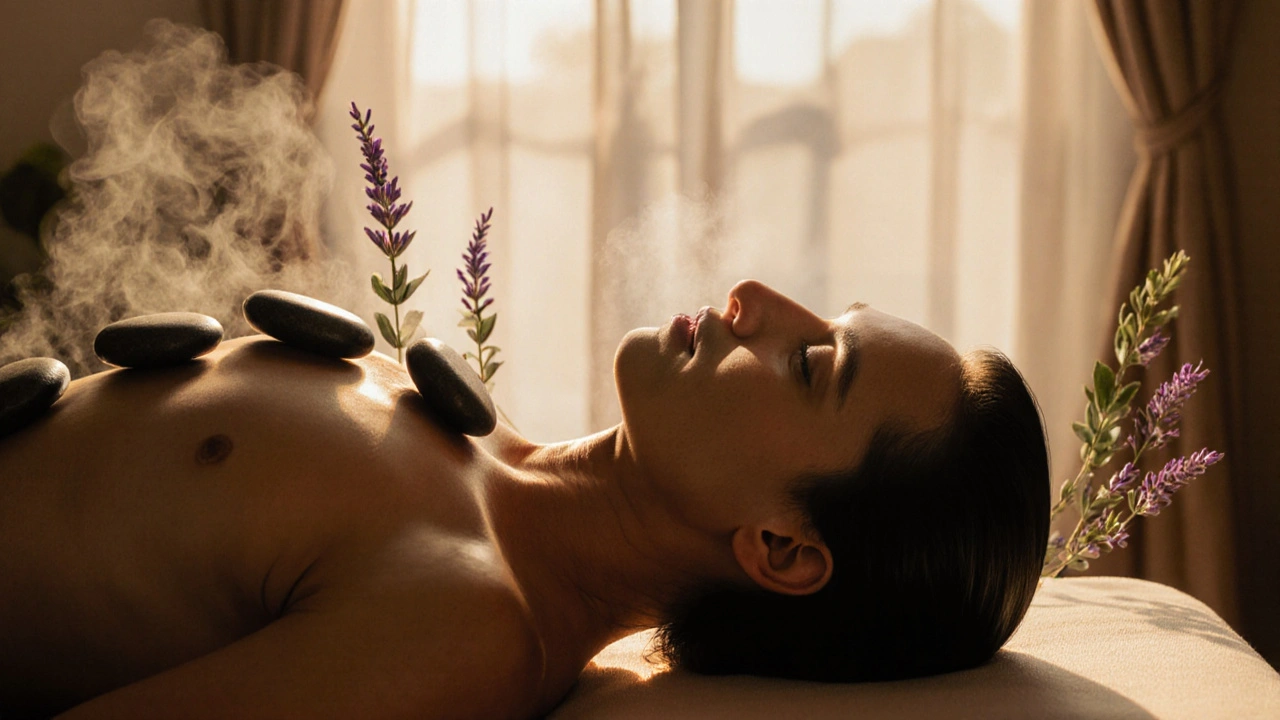
You’ve just finished a long yoga session. Your muscles are warm, your breath is slow, and your mind feels lighter. But there’s still that tightness in your hips, the lingering ache in your shoulders, the subtle tension you can’t quite shake. What if you could deepen your recovery-not with more stretching, but with heat, weight, and stillness?
That’s where hot stone massage comes in. It’s not just a luxury spa treat. For yogis, it’s a game-changer.
Why Hot Stone Massage Works So Well After Yoga
Yoga stretches your muscles, opens your joints, and calms your nervous system. But it doesn’t always release deep-seated tension. That’s the kind of tightness that lives in your fascia-the connective tissue wrapping your muscles like a second skin. When you hold poses like pigeon or downward dog day after day, your fascia can get stuck. It doesn’t just loosen with time.
Hot stone massage uses smooth, heated basalt stones, usually warmed to around 120-130°F (49-54°C). These stones are placed along your spine, over your muscles, and gently moved across your body. The heat doesn’t just feel good-it penetrates deeper than your hands ever could. Studies show that heat increases blood flow by up to 40% in targeted areas. More blood means more oxygen, more nutrients, and faster removal of lactic acid and other metabolic waste.
Think of it like this: yoga is the workout. Hot stone massage is the cooldown that actually works.
What Happens to Your Body During a Hot Stone Session
When the stones touch your skin, your body doesn’t just feel warmth-it responds. Your blood vessels dilate. Your muscles relax involuntarily. Your parasympathetic nervous system kicks in-the one responsible for rest, digestion, and healing.
For yogis, this means:
- Your hamstrings loosen faster after a long vinyasa flow
- Your lower back releases tension that’s been building since your last seated meditation
- Your shoulders drop, even if you’ve been holding stress there for weeks
It’s not magic. It’s physics and biology. Heat reduces muscle spindle activity-the signals that tell your muscles to stay tight. The stones act like gentle pressure points, melting away knots without the pain of deep tissue work. You don’t need to grit your teeth. You just breathe. And let go.
How It Boosts Your Yoga Progress
Let’s be real: progress in yoga isn’t about how deep you can get into a pose. It’s about how consistently you show up. And if you’re sore, stiff, or mentally drained after each class, you’re less likely to come back.
Hot stone massage removes that barrier. After just one session, many yogis report:
- Deeper forward folds without straining
- More ease in hip openers
- Longer meditation sessions because the body isn’t screaming for attention
One regular student at a studio in Utrecht told me she’d been stuck in half pigeon for months. No matter how much she stretched, her hip wouldn’t open. After three hot stone sessions spaced two weeks apart, she could finally rest her forehead on the floor. Not because she worked harder. Because her body finally relaxed enough to let go.
That’s the secret: hot stone massage doesn’t force your body into flexibility. It invites it.
Hot Stone Massage vs. Other Recovery Methods
You’ve tried foam rolling. Maybe even ice baths. You’ve done breathwork, Epsom salt soaks, even acupuncture. But here’s the thing: none of those combine deep heat, consistent pressure, and full-body calm like hot stone therapy.
Here’s how it stacks up:
| Method | Heat Penetration | Relieves Fascia Tension | Calms Nervous System | Time Needed |
|---|---|---|---|---|
| Hot Stone Massage | Deep (up to 2 inches) | Yes | Strongly | 60-90 minutes |
| Foam Rolling | Superficial | Moderate | Minimal | 15-30 minutes |
| Ice Bath | No | No | Moderate | 10-15 minutes |
| Swedish Massage | Light | Some | Yes | 60 minutes |
| Epsom Salt Soak | Surface only | Minimal | Moderate | 20-30 minutes |
Hot stone massage wins on depth, duration, and holistic effect. It doesn’t just target one area. It wraps your whole body in warmth, like a blanket made of stones.
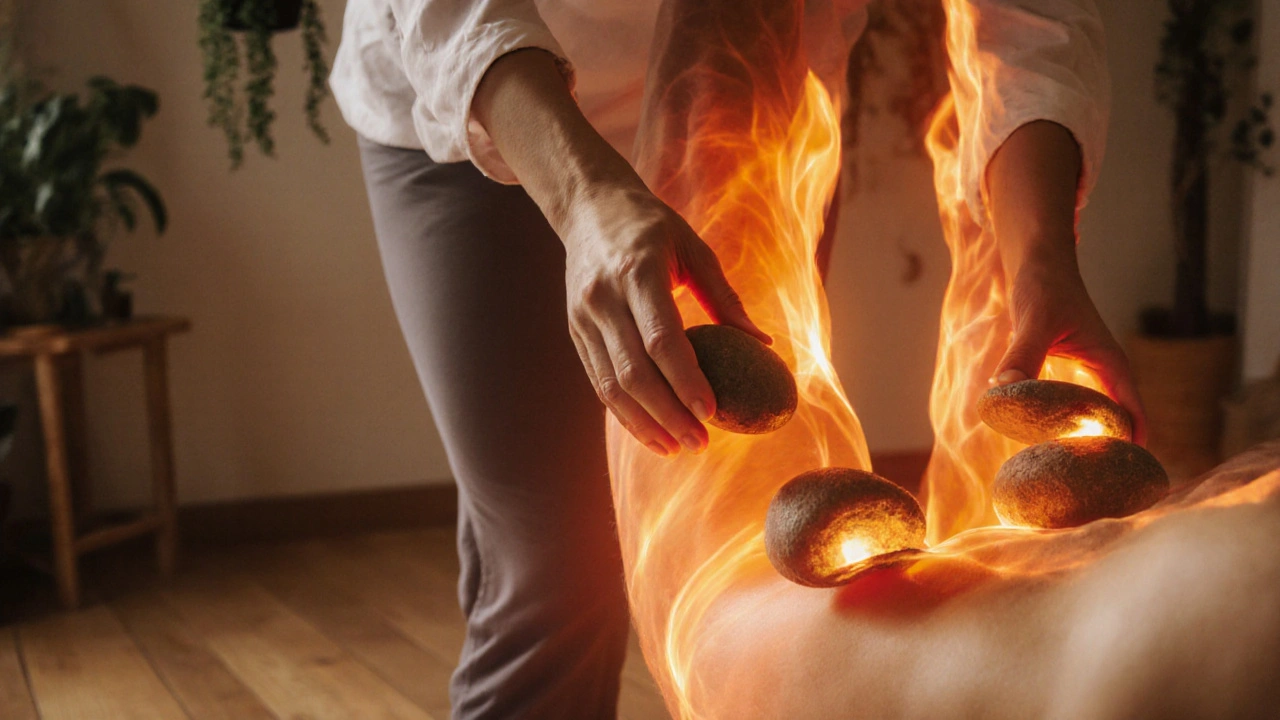
What to Expect During Your First Session in Amsterdam
You walk into a quiet room, softly lit. The air smells like lavender and eucalyptus. You lie face down on a heated table. The therapist places warm stones along your spine-starting at your sacrum, moving up to your neck. Then, they glide stones over your calves, your thighs, your shoulders.
The heat is intense at first-not burning, but deep. It feels like sunlight soaking into your skin. As the stones move, you feel the tension melt. Your breath slows. Your jaw unclenches. You forget you’re even on a table.
They might use smaller stones between your toes, or rest one on your third eye during a brief pause. No music. Just the sound of your breathing and the quiet clink of stones being reheated.
After 75 minutes, you sit up slowly. Your body feels heavy-but in the best way. Like you’ve been held. Not fixed. Held.
Where to Find Authentic Hot Stone Massage in Amsterdam
Amsterdam has dozens of spas, but not all offer true hot stone therapy. Many just warm a few stones and call it a day. Real hot stone massage uses:
- Basalt stones (volcanic rock, holds heat for over an hour)
- Stones heated in water (never microwaved)
- Therapists trained in stone placement and flow
Look for places like De Stenen Zorg in De Pijp, or Yoga & Stone near the Amstel River. Both specialize in combining yoga recovery with traditional stone therapy. Ask if they use a stone warmer and if the therapist has completed a certified hot stone course. If they hesitate, keep looking.
Most places offer 60-minute or 90-minute sessions. For yogis, 90 minutes is ideal. You need time for the heat to sink in.
How Often Should You Do It?
If you practice yoga 3-5 times a week, aim for a hot stone massage every 2-3 weeks. That’s enough to keep fascia loose without overdoing it. If you’re recovering from an injury or going through a particularly intense yoga retreat, once a week for a month can reset your body completely.
Some yogis book one right before a workshop or teacher training. Others do it after a long trip, when their body’s been sitting still for hours. There’s no wrong time. Only what your body is asking for.
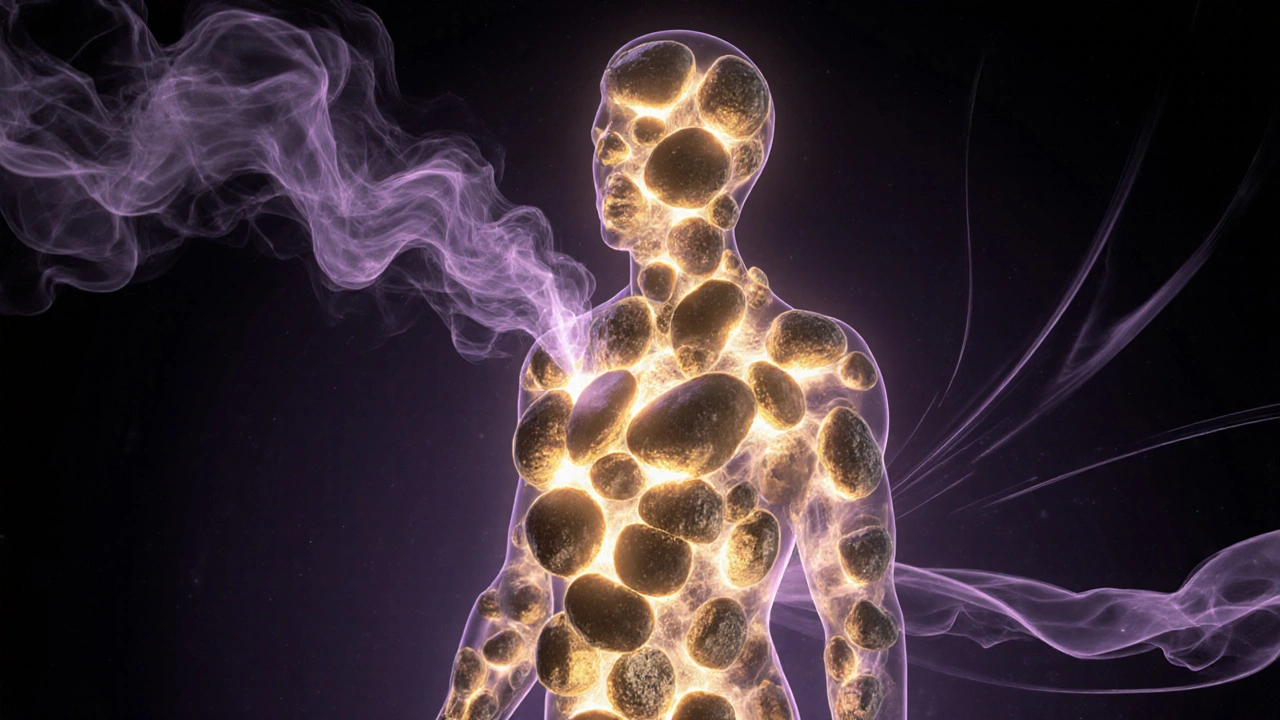
Who Should Avoid Hot Stone Massage?
It’s safe for most people-but not everyone.
Avoid it if you have:
- Open wounds or recent burns
- Severe varicose veins
- Diabetes with poor circulation
- Are pregnant (unless your therapist is trained in prenatal stone therapy)
- Have a fever or active infection
Always tell your therapist about any health conditions. They’re not there to judge-they’re there to adapt.
Can You Do It at Home?
You can buy basalt stones online. You can even heat them in a pot of water. But here’s the truth: the real benefit isn’t just the heat. It’s the intention. The presence. The skilled hands that know where to press, when to pause, how long to hold.
Home stone massage feels nice. But it doesn’t have the same depth. It’s like trying to learn yoga from YouTube videos. You get the shape-but not the soul.
Save home stones for occasional use. Let the professionals handle the deep work.
How to Maximize the Benefits
After your session:
- Drink plenty of water. Your body is flushing out toxins.
- Wait at least 4 hours before doing yoga. Let your body integrate the release.
- Try a quiet walk in Vondelpark. No phone. Just movement and air.
- Journal for 5 minutes. What did you feel? Where did the tension go?
These small rituals turn a massage into a ritual. And rituals are what keep yoga alive beyond the mat.
Can hot stone massage help with chronic pain from yoga injuries?
Yes-especially for chronic tension in the lower back, hips, or shoulders. The deep heat reduces inflammation and increases circulation to injured tissues. Many physical therapists in Amsterdam now recommend hot stone massage as part of rehab for yogis with recurring strains. It won’t fix structural damage, but it can dramatically reduce pain and restore mobility.
Is hot stone massage better than a regular massage after yoga?
It’s not better-it’s different. A regular Swedish massage is great for general relaxation. Hot stone massage goes deeper, especially into fascia and connective tissue. If you’re a serious yogi who feels tight even after stretching, hot stone gives you something your hands or foam roller can’t.
Do I need to be flexible to benefit from hot stone massage?
No. In fact, people who are stiffest often benefit the most. Hot stone massage works on the tissues that are tightest, not the ones that are already loose. You don’t need to touch your toes. You just need to lie down and breathe.
Can I combine hot stone massage with other therapies like acupuncture or cryotherapy?
Yes, but not on the same day. Hot stone massage increases circulation and relaxes tissues. Cryotherapy does the opposite-it reduces inflammation by constricting blood vessels. If you want both, space them out by at least 48 hours. Acupuncture pairs well, but do it before the massage, not after.
How long do the effects of a hot stone massage last?
Most people feel the immediate release for 3-5 days. The deeper benefits-like improved flexibility and reduced chronic tension-build over time. With regular sessions every 2-3 weeks, many yogis report lasting changes in their range of motion and recovery speed within 6-8 weeks.
Yoga teaches you to listen to your body. Hot stone massage teaches you how to let it rest. Together, they don’t just make you stronger. They make you softer. And sometimes, that’s the most powerful practice of all.
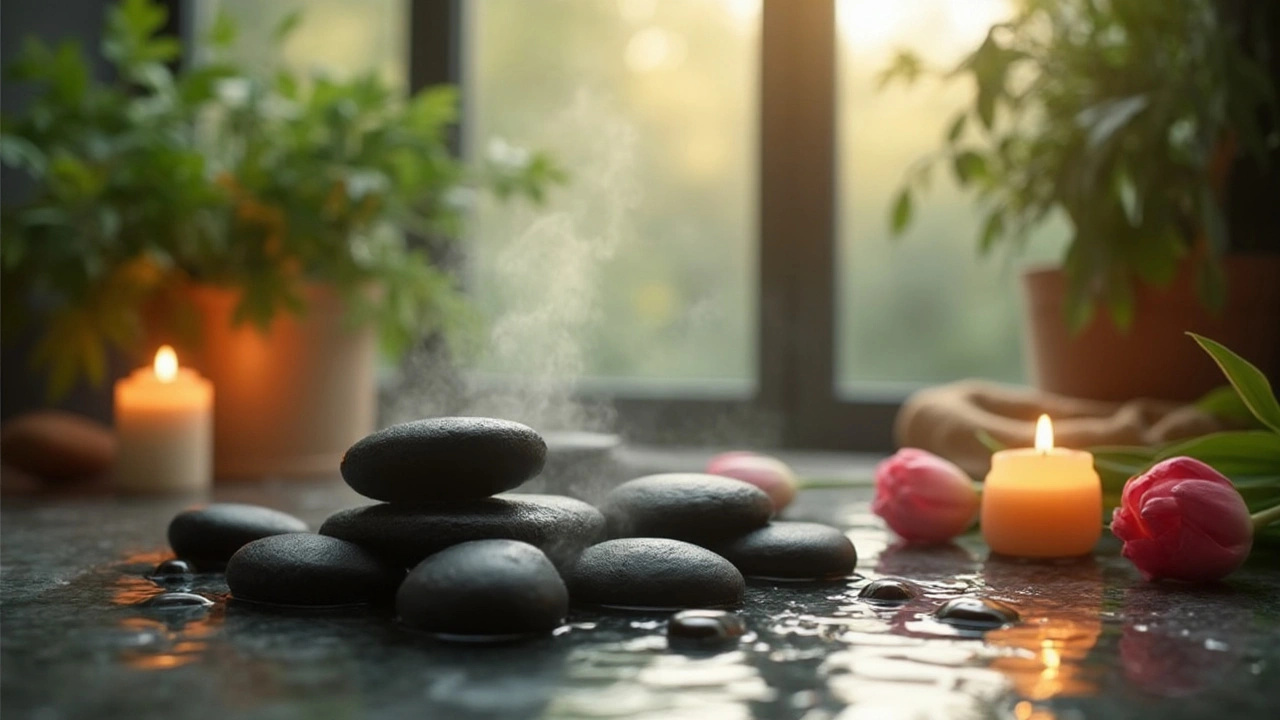
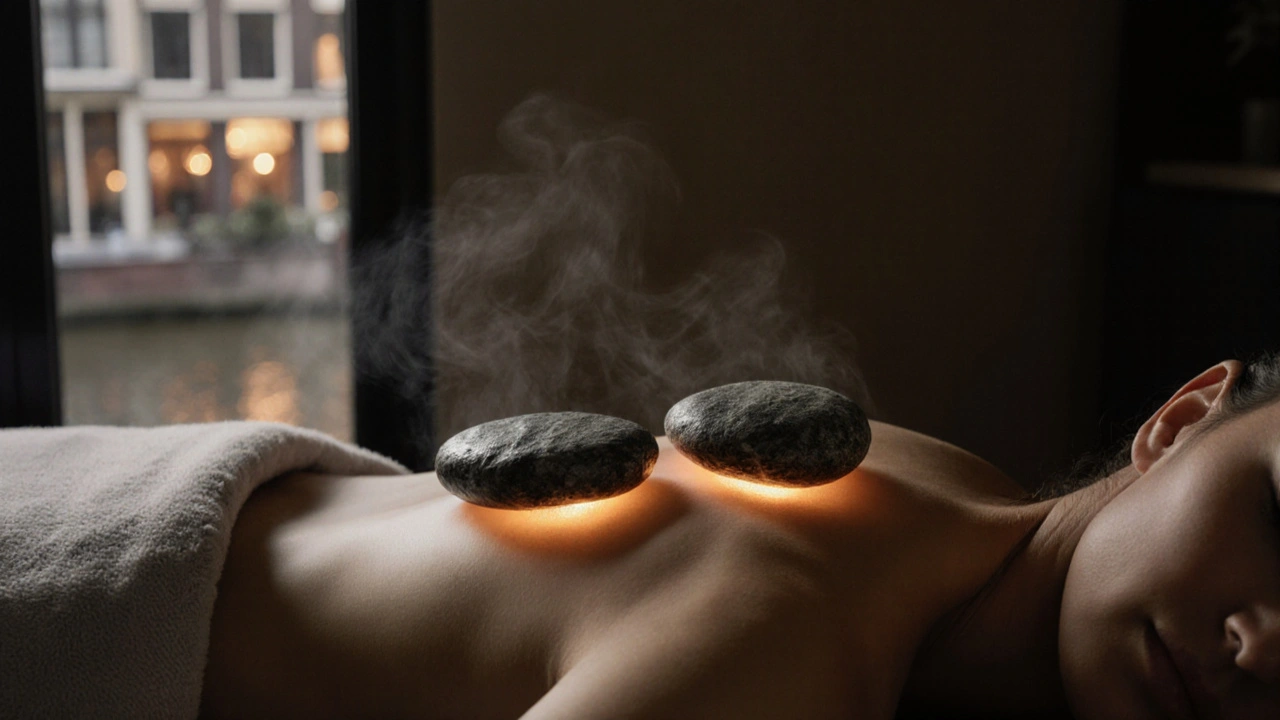

Summer Perkins
November 4, 2025 AT 20:46I tried this after a bad yoga session and my hips finally stopped screaming. No more wincing in pigeon pose. Just quiet. I didn't even know my body was holding that much tension.
It's not about flexibility. It's about letting go.
Jimmy Jew
November 6, 2025 AT 01:49Man, I used to think hot stone was just a fancy spa gimmick until I went to that little place in Portland. The therapist didn't even talk. Just placed the stones like they were reading my body. I cried. Not because it hurt. Because I hadn't felt that safe in years.
Yoga taught me to breathe. This taught me to surrender.
Arlene Vanness
November 7, 2025 AT 07:27The scientific basis for heat penetration and fascial release is well documented in physiotherapy literature. The increase in local blood flow cited aligns with peer-reviewed studies on thermotherapy. However, the anecdotal claims regarding meditation depth and long-term flexibility gains require longitudinal data to substantiate.
Nonetheless, the physiological mechanism is sound.
Buddy Latham
November 8, 2025 AT 23:10I’ve been doing yoga for five years and never thought to pair it with this. I went last week after a 10-day retreat and felt like I’d been unplugged from a machine. My shoulders haven’t been this loose since college.
Do it. Your body will thank you. No fancy words needed.
Gerald White
November 10, 2025 AT 00:08They don’t want you to know this but the stones are loaded with magnetic minerals. The real healing isn’t the heat-it’s the geothermal resonance syncing with your chakras. That’s why they won’t let you do it at home. Corporations control the basalt supply. Look up the patent filings. They’re hiding the truth.
And don’t get me started on the lavender. It’s not for relaxation. It’s a sedative.
Kevin Puls
November 11, 2025 AT 05:23As someone who’s done both hot stone and deep tissue for chronic lower back issues from years of asana, I can say this: if your body is holding onto structural tension, heat is the only thing that gets past the guardrails your nervous system puts up.
Deep tissue hurts. Hot stone invites. And that’s the difference between forcing change and allowing it.
Also, the table at De Stenen Zorg? Heated. Not just the stones. That’s the detail most places skip. If they don’t mention it, they’re cutting corners.
Oskar Banaszek
November 12, 2025 AT 16:01This is just another wellness cult product wrapped in pseudoscientific fluff. Anyone who thinks a rock can fix fascia hasn’t read a single biomechanics paper. Foam rolling works better. And if you’re that tight after yoga, maybe you’re overtraining or have poor form.
Stop chasing magical solutions. Build strength. Stop paying $150 for a warm rock.